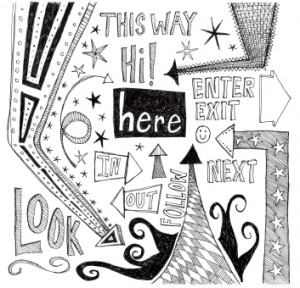If I can borrow Rodney Dangerfield's signature line, 'segues don't get no respect'.
For anyone unfamiliar with them, segues are those bridges-between-thoughts that get us from one idea to another. And carry us across and through different parts of a story. Listen to any decent comic's routine and you'll hear how effortlessly they're interwoven into the act.
Unfortunately, too many communications people ignore segues when they're preparing a presentation. They flip from slide to slide as if each was a separate item on a shopping list.
Does this sound familiar: you're watching someone talk you through a powerpoint and each time they press advance, they glance at the screen with a befuddled look on their face and say, 'Um yes…social media?', or whatever the title might be. Yipes. You're looking for a quick exit but know it's probably too late.
What they're missing is an understanding of flow; how to use the twists and turns to take us on an memorable, insightful and entertaining ride.
Here are five easy improvements:
- Start with your story – what are you trying to convey? And if you don't have a good story, you'd better create one. (I'm assuming you know the basics of a good story, if not pick up any kid's book…)
- Be visual.
- Make sure it's not all one-note. High energy is no substitute for wit or drama. My recent Showbiz post has some tips.
- Build in transitions, anecdotes and asides that get you from one point to the next.
- Then memorize the order of your slides so you don't look so surprised when the next one appears. Memorizing also helps you think on your feet and bridge back to your talk if someone asks you a question.
And believe it or not, most eveyone in your audience is able to read – you don't have to do it for them.
If you want an amazing presentation resource, read Gar Reynolds' Presentation Zen.
In the meantime, zen is a discipline that requires patience, persistence and practice. So don't give up. Your audience will thank you.
Do you have any other tips to share?


I recently returned from a self-imposed, what I entitled my “Ernest Hemingway writing retreat”. (and how prophetic that the Toronto Star came out with its Hemingway Papers on my birthday, May 1st, just after I’d planned and named my retreat).
The ability to deliver a message seamlessly, in an engaging storytelling style, with inflection, intonation and pace/pause, it what makes a presentation engaging. It’s like an athlete being in “flow”. When the moves become and appear effortless and seamless.
So my tips would be:
Practice well and often
Slow down your speed of delivery (having been a TV broadcaster for CBC, one of the first things we learned was pacing)
Use inflection and intonation
Relax (breathing exercises and visualization prior help)
Speak in your own voice: don’t imitate others
Smile. It raises the endorphins and creates a feel-good feeling in yourself and others.
I like your zen advice:) Cheers! Kaarina
P.S. The breaks that I thought were in the final points didn’t appear after I’d spaced down in between, so it looks like one giant run-on sentence. Don’t know what happened there:(
Thanks for your suggestions @KDillabough. They’re all good. I take the pacing/speed to heart because I sometimes tend to rush through things and have to remember to get my energy from the story instead. No worries about the spacing – I liked the stream!
It’s the same thing with writing – a story without transitions isn’t a story at all.
Thanks @ginidietrich. Sometimes I think our limited attention spans gets us thinking (speaking?) in starts and stops and we need to smooth out a few of those edges…